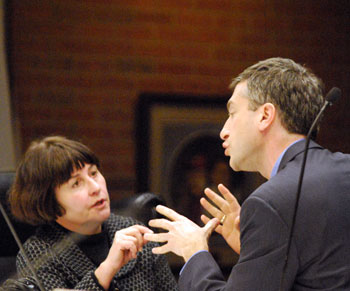Art Commission Contends with Limbo Status
Ann Arbor public art commission meeting (Dec. 19, 2012): Just over two weeks after the Ann Arbor city council voted to halt spending on the Percent for Art program, public art commissioners held their regular monthly meeting and discussed implications of that council decision. The moratorium on spending lasts until April 1, 2013.
Marsha Chamberlin, AAPAC’s chair, briefed commissioners on a Dec. 11 meeting of the city council committee that will be making recommendations on the future of Ann Arbor’s public art program. The committee’s work comes in the wake of a failed public art millage that voters rejected on Nov. 6. That committee includes councilmember Sabra Briere, who attended AAPAC’s Dec. 19 meeting as well.
At the meeting, Briere participated in a discussion with commissioners about the source of funding for a hanging sculpture to be installed in the lobby of the Justice Center. AAPAC and city councilmembers have been under the impression that the $150,000 project – called “Radius,” by Ed Carpenter – was part of the city’s Percent for Art budget. However, it now seems that’s not the case, based on communications from the city’s chief financial officer. The news stunned commissioners, who noted that the project appears in the budget summaries they regularly receive – including one provided in the Dec. 19 meeting packet – as a line item, under “Court/PD Facility.” [.pdf of December 2012 budget summary]
By way of background, during the May 7, 2012 city council meeting when the Radius project was ultimately approved, councilmembers debated the issue for about an hour. Specifically, Jane Lumm (Ward 2) had proposed an amendment that would have canceled Carpenter’s project and appropriated the art project funds to investments in the city hall building. Her amendment failed, with several councilmembers – and assistant city attorney Mary Fales – arguing that the public art ordinance prohibits the transfer of public art funds to other funds.
A new, different understanding that seems to have emerged is the following: The money for public art in the Justice Center building budget was not set aside as an application of the public art ordinance, but rather was set aside administratively – in February 2009, well after the building fund had been established. The building fund had been established prior to 2007, when the public art ordinance was enacted. So the 2009 set-aside was made in the spirit of the 2007 public art ordinance, applied in some sense retroactively. In a phone interview, Briere told The Chronicle that this is the understanding she has of the situation. And in response to an emailed query from The Chronicle, Stephen Kunselman (Ward 3) – who also serves on the council’s public art review committee – confirmed he had the same understanding. That understanding has implications for use of the balance of the $250,000 that was set aside for Justice Center art.
In other action at the Dec. 19 meeting, commissioner John Kotarski expressed concern about AAPAC’s task force process, after attending a recent session for the East Stadium bridges project. He didn’t feel the task force is getting sufficient administrative support as it works to select up to five finalists from a set of 36 submissions. To help, he proposed allocating $5,000 to hire a consultant who would serve as a curator to conduct an initial vetting of the artists. The suggestion did not gain much traction among other commissioners, at least for this project, though the idea of a facilitator seemed well-received.
Kotarski updated commissioners on a course that Roland Graf, an assistant professor at the University of Michigan’s School of Art & Design, will be teaching this coming semester called “Public Art and Urban Intervention.” Graf intends to make assignments related to public art in Ann Arbor and on the UM campus, and it’s expected that students will eventually make presentations of their projects to AAPAC.
Kotarski also was the catalyst for a review of AAPAC’s long-term strategic plan for fiscal 2013-2016, prompting commissioners to identify the status of each objective. Several objectives are on hold, pending the outcome of the city council’s review of the overall Percent for Art program.
The council’s pending action also has resulted in some uncertainty regarding AAPAC appointments. Terms for Cathy Gendron and Connie Brown expire on Dec. 31, 2012. They’ve agreed to continue serving until the council makes a decision about the Percent for Art program. The vacancy left by the resignation of Theresa Reid in November remains unfilled. Nominations to AAPAC are made by the mayor and confirmed by city council. [Full Story]





